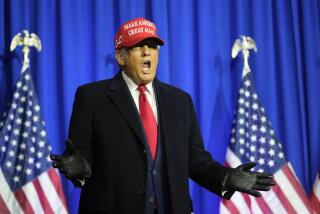Trump administration takes formal step to launch renegotiation of NAFTA
May 18, 2017, 8:11 a.m. Reporting from Washington
Trump administration takes formal step to launch renegotiation of NAFTA
The Trump administration, taking the first formal step toward overhauling the North American Free Trade Agreement, on Thursday notified Congress of its intent to renegotiate the pact with Canada and Mexico in 90 days.
The letter to lawmakers, sent by the newly confirmed U.S. Trade Representative Robert Lighthizer, means that Trump’s trade officials could launch talks with Canadian and Mexican officials as soon as Aug. 16.
Lighthizer, during a hastily called telephone briefing with reporters, said that in giving notice to Congress of a 90-day consultation period – which is required under so-called fast-track trade legislation – President Trump was moving to fulfill his promise to “permanently reverse the dangerous trajectory of American trade.”
During the campaign and as president, Trump repeatedly trashed NAFTA as a “disaster,” calling it the worst trade agreement ever. Just weeks ago, Trump said he was close to issuing an order to withdraw from NAFTA, only to reconsider the action hours later.
Lighthizer, a veteran trade lawyer and negotiator who was confirmed last week as Trump’s last Cabinet member, on Thursday took a much more conciliatory tone.
Although Trump has often held out the threat of pulling out of NAFTA, Lighthizer said that his hope and expectation was that such action would not be necessary, noting that “as a starting point for renegotiations, we should build what has worked in NAFTA and change what has not.”
He called his Mexican and Canadian trade counterparts “tremendously talented individuals,” and said the parties were “all entering the process in good faith.”
Canada and Mexico are the United States’ top trading partners after China. Two-way trade in goods and services between the U.S. and Canada has nearly tripled since NAFTA took effect, and U.S. trade with Mexico has jumped more than six-fold since then. Last year the U.S. had a $62.7 billion trade deficit with Mexico and a $8 billion surplus with Canada.
Lighthizer said he believed that NAFTA, which took effect in January 1994, had proved successful for some sectors, including investment services, agriculture and energy. But he singled out manufacturing as an area of deficiency, particularly involving Mexico.
He also noted that the 23-year-old agreement did not include provisions related to digital trade and that matters of the environment were “an afterthought.”
“Our aim is that NAFTA be modernized,” Lighthizer said in a letter notifying Senate and House leaders of both parties. Among the provisions that Lighthizer cited that would be addressed are intellectual property rights, regulatory practices, state-owned enterprises, labor and environment. The list did not mention currency practices, something that congressional Democrats have sought to be included in trade deals, as have such groups as labor unions and the American Automotive Policy Council, a lobbying group for Ford, General Motors and Fiat Chrysler.
While lawmakers had anticipated the notification, their reaction to it Thursday reflected a range of attitudes reflecting the complicated trade politics in which Trump will be relying largely on Democratic members to push through significant changes in the agreement.
Rep. Henry Cuellar (D-Texas), who represents a border district in the Laredo area, said he was glad to see that the administration was moving to “update NAFTA, not dismantle it.”
Sen. Bob Casey (D-Pa.), calling NAFTA “deeply flawed,” commended the step to overhaul the agreement but insisted that “we must see real details on how the administration intends to level the playing field for our workers.”
Many Republican lawmakers have been wary of Trump’s anti-free trade rhetoric, and concerned about the risks of hurting the economy in opening up NAFTA.
“Congress looks forward to working hand-in-hand with the Trump administration to achieve the best deal possible for American workers and our economy,” said House Speaker Paul Ryan (R-Wis.).
Lighthizer’s letter did not mention specific areas in manufacturing that he planned to address, but Trump and his administration officials, including Commerce Secretary Wilbur Ross, who with Lighthizer is leading the charge on trade, have been particularly critical of NAFTA’s effect on domestic car production and suppliers, many of them now in Mexico.
Trump’s trade officials also are likely to try to limit Canadian and Mexican companies’ access to U.S. government procurement contracts, and the administration is almost certain to seek the elimination of a provision that allows an arbitration panel to decide complaints about goods that are allegedly dumped or subsidized by governments – a change that Canada in particular is expected to resist.
Chrystia Freeland, Canada’s minister of Foreign Affairs, acknowledging the notification to the U.S. Congress, said Thursday: ““We are at an important juncture that offers us an opportunity to determine how we can best align NAFTA to new realities — and integrate progressive, free and fair approaches to trade and investment.”
The Trump administration recently slapped tariffs on Canadian lumber shipped to the U.S., claiming they are unfairly subsidized, and the two sides have sparred over Canada’s dairy import policies.
Like Canada, Mexico has been preparing for the negotiations by consulting with domestic businesses and other parties. Trump had threatened to levy tariffs on Mexican goods, sparking concerns about a trade war, and bilateral tensions rose earlier this year when Trump insisted that Mexico pay for a wall across the border.
On Thursday, the Mexican government issued a statement that it “welcomes this important step in the United States’ domestic process to modernize NAFTA. We reaffirm our willingness to update the agreement in order to successfully address the challenges of the 21st century.”
In keeping with Trump’s belief that the U.S. has been short-changed in multilateral trade agreements, Lighthizer said he expected a lot of the negotiations to be bilateral, although he did not take a hardened position on that.
In the letter to lawmakers released Thursday morning by his office, Lighthizer described the broad goal of opening up NAFTA as getting a deal that would produce higher-paying jobs for Americans and grow the economy. Lighthizer said specific U.S. objectives for a revised NAFTA would be provided to Congress at least 30 days before the start of the talks.
Lighthizer said he hoped that negotiations could be concluded this year.
1:30 p.m.: This story was updated with additional reaction.
Latest updates
More to Read
Get the L.A. Times Politics newsletter
Deeply reported insights into legislation, politics and policy from Sacramento, Washington and beyond. In your inbox three times per week.
You may occasionally receive promotional content from the Los Angeles Times.






